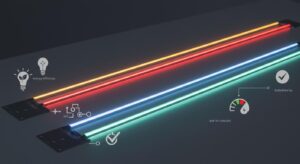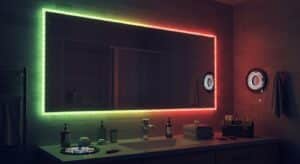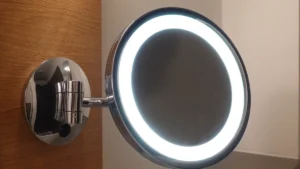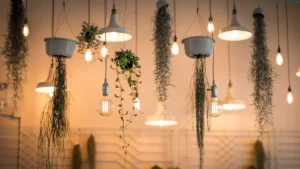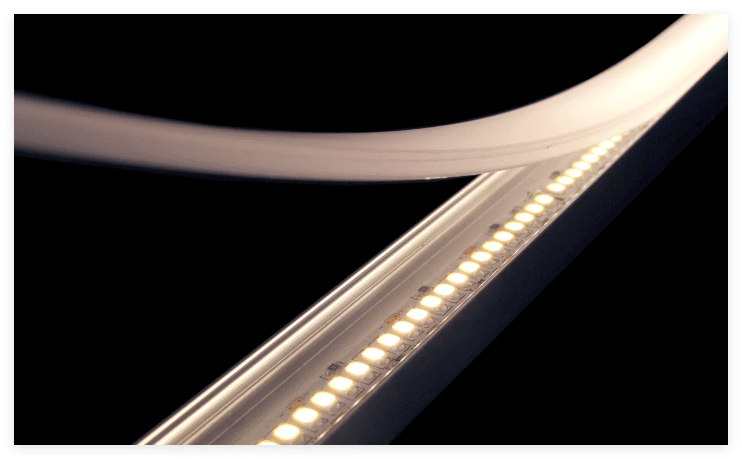
High-density LED strips are lights where the LEDs are positioned closely together, providing exceptionally bright and uniform illumination. These strips can emit up to 10,000 lumens per metre, making them ideal for demanding tasks such as office lighting. They are highly efficient, delivering up to 200 lumens per watt, ensuring both excellent performance and energy savings.
If you’re exploring high-density LED strips on platforms like Reddit or seeking improved lighting for your project, these strips are both versatile and reliable.
Key Takeaways
High-density LED strips give strong and even light, perfect for workspaces and showing products.
They use less energy and last over 50,000 hours, saving money on power and replacements.
Pick LED strips by checking brightness, colour tone, and water resistance to match your lighting needs.
What Are High-Density LED Strips?
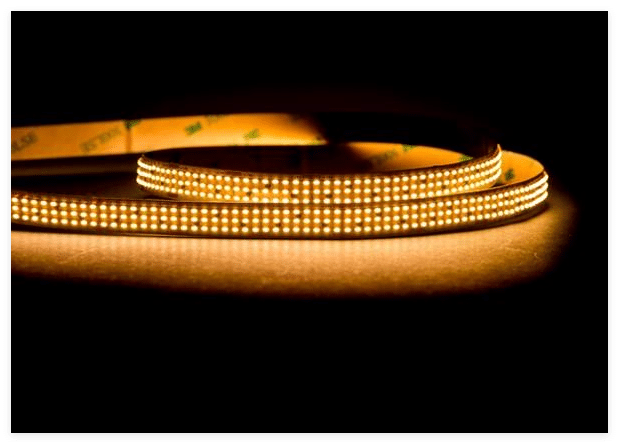
Defining High-Density LED Strips
High-density LED strips are special lights with LEDs placed close together. They usually have 60 or more LEDs per metre. This setup gives brighter and smoother light than regular strips. These strips can produce between 300 and 1,000 lumens per metre. For example, a 5-metre strip can give 1,200 lumens while using only 24 watts. This makes them great for homes and businesses.
The performance of these strips is measured by key factors. These include how bright they are, how much power they use, and their efficiency. Other things, like the Colour Rendering Index (CRI), show how well colours look under the light. The table below explains these factors:
Metric | Description |
|---|---|
Lumen output | How bright the light looks to people. |
Power consumption | How many watts the strip uses. |
Efficiency | How much light is made per watt of power. |
Luminous Intensity Distribution | Shows the angles where the light shines. |
CRI | How true colours look compared to natural light. |
Fidelity Index (TM-30) | Measures how accurately colours are shown using 99 samples. |
Gamut Index (TM-30) | Shows how vibrant the colours appear. |
CQS | Another way to measure how good the colours look. |
By knowing these details, you can pick the best high-density LED strip for your needs.
Benefits of High-Density LED Strips
High-density LED strips have many advantages, making them a top choice for lighting. One big benefit is their long life. They can last over 50,000 hours, so you won’t need to replace them often. This also saves money on maintenance. They are tough and can handle rough conditions, with waterproof options for outdoor use.
Another advantage is their flexibility. You can adjust their length and shape to fit different projects. Whether you want colourful RGB lights for a party or bright light for work, these strips work well. They also save energy, giving bright light without high electricity costs.
The table below shows the main benefits of high-density LED strips:
Benefit/Improvement | Description |
|---|---|
Longevity | Lasts over 50,000 hours, saving money on replacements. |
Durability | Strong enough for tough conditions, with waterproof options for outdoors. |
Versatility | Can be adjusted for different uses, including RGB effects. |
Enhanced Lighting | Gives bright, even light, great for showing products in shops. |
Energy Efficiency | Uses less power, cutting electricity costs. |
These features make high-density LED strips a smart and affordable choice for homes and businesses.
Common Applications of High-Density LED Strips
High-density LED strips can be used in many places. At home, they are great for lighting under kitchen cabinets. This makes the space look modern and useful. You can also use them in living rooms or bedrooms for stylish accent lighting.
In shops, these strips are perfect for displays. Bright and even light helps customers see products better. Offices also benefit from these strips, as they reduce eye strain and improve focus. Outdoors, they are used for garden lights or to highlight buildings, thanks to their strength and waterproof designs.
For creative ideas, these strips are very flexible. Designers and artists use them for signs or stage lighting. Whether you need to light up a small area or create a bold effect, these strips work brilliantly.
Tip: When choosing between high-density and standard-density LED strips, think about your project’s needs. High-density strips are best for brighter and smoother lighting.
Comparing High-Density and Standard-Density LED Strips
Differences in LED Density and Performance
High-density and standard-density LED strips differ in LED numbers per metre. High-density strips have more LEDs close together. This gives brighter and smoother light. Standard-density strips have fewer LEDs, making them less bright but cheaper. They are good for basic lighting needs.
The table below shows how these LED types compare:
LED Type | Brightness | Density | Application Examples |
|---|---|---|---|
3528 | Lower | Standard | Affordable for everyday lighting |
5050 | Higher | High | Best for bright and focused lighting |
High-density strips perform better due to their close LED spacing. They give steady light without dark spots or shadows. This makes them great for areas needing bright, even light, like under cabinets or in coves. Standard-density strips are less bright but work well for low-cost projects.
When to Choose High-Density LED Strips
Pick high-density LED strips when you need bright, even lighting. They are ideal for places like kitchens, offices, or shops where light quality is important. These strips mix colours well, making them great for decorative lighting and accents.
For detailed tasks like reading or crafting, high-density strips provide clear light. They are also perfect for creative projects, offering vibrant colours and smooth lighting effects. If you want durable and energy-saving lights, these strips are a smart choice. They last long and help lower electricity bills.
Tip: Use high-density LED strips for top-quality lighting. Whether for home upgrades or business designs, their brightness and flexibility make them a great investment.
Factors to Think About When Buying High-Density LED Strip Lights
Brightness and Lumens per Metre
When picking high-density LED strip lights, brightness matters a lot. Brightness is measured in lumens per metre. This shows how much light the strip gives off. Strips with high lumens are great for bright lighting, like in workspaces or shops. But, you should also think about energy use. Bright strips might not always save energy. New LED technology helps turn power into light more efficiently.
For example, some LED strips can give 10,000 lumens per metre. They do this while using energy wisely. This means you get bright light without big electricity bills. Always check the details to see if the strip meets your needs.
Tip: Use strips with high lumens per metre for bright areas like kitchens.
Colour Temperature and CRI
Colour temperature and Colour Rendering Index (CRI) affect light quality. Colour temperature, measured in Kelvins (K), shows if the light looks warm or cool. Warm light (2700K–3000K) is cosy, while cool light (4000K–5000K) suits workspaces.
CRI shows how well colours look under the light. A CRI of 80+ is good for most places. A CRI of 90+ is better for places needing true colours, like art studios. High-density LED strips often have great colour temperature and CRI, giving clear and vibrant lighting.
Step | Description |
|---|---|
1 | Find the colour temperature using spectral data. |
2 | Shine the light on test colour samples (TCS). |
3 | Measure the colours reflected from the samples. |
4 | Compare these colours to natural daylight. |
5 | Calculate the R score for each sample. |
6 | Average the scores to get the CRI. |
Note: For top lighting, choose strips with high CRI and the right colour temperature.
IP Rating for Water and Dust Protection
If your LED strips will face water or dust, check the IP rating. The IP rating has two numbers. The first shows protection against dust. The second shows protection against water.
For indoor spaces, IP20 is fine. For outdoor or wet areas, pick IP65 or higher. These strips have a protective layer to keep them safe and working well.
Tip: Match the IP rating to where you’ll use the strips for safety.
Power Supply and Energy Efficiency
The power supply affects how well your LED strips work. High-density strips need strong power sources for their higher wattage. Good strips use at least 10 watts per metre. This gives bright light without overloading. Common voltages are 12V and 24V. Longer strips work better with 24V.
Energy efficiency is also important. Look for strips that use advanced technology to save power. The table below shows how wattage affects daily use and monthly costs:
Wattage | Daily Use (kWh) | Monthly Cost (£) |
|---|---|---|
100W | 1.0 | 3.60 |
150W | 1.5 | 5.40 |
200W | 2.0 | 7.20 |
250W | 2.5 | 9.00 |
300W | 3.0 | 10.80 |
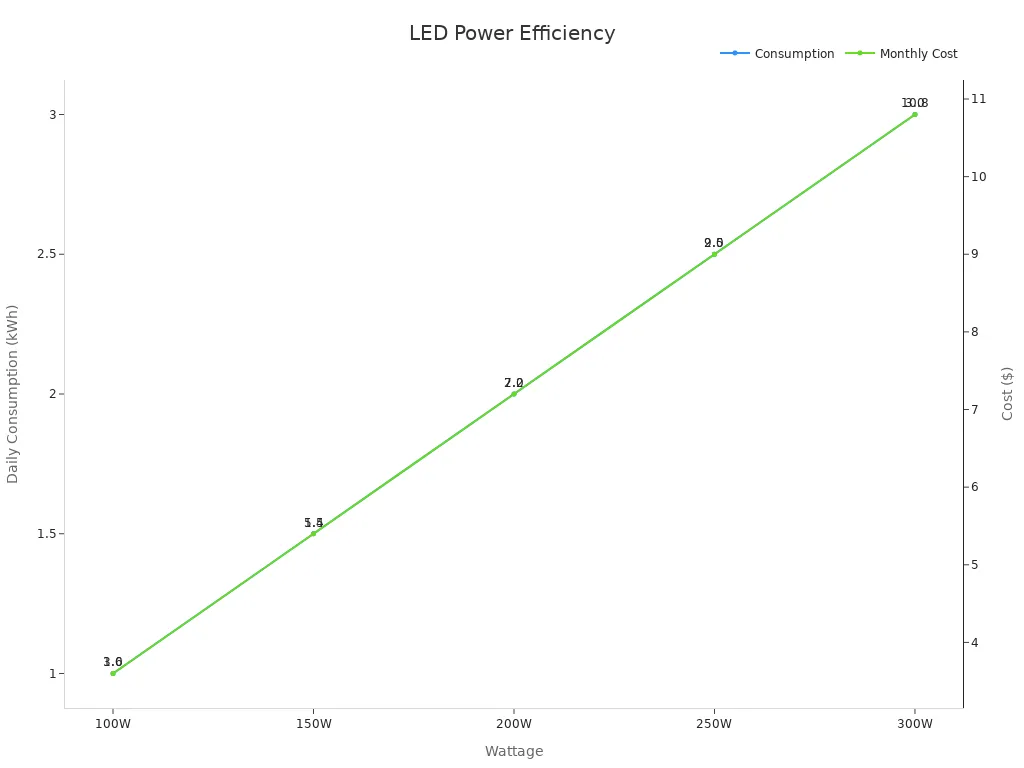
Note: Pick energy-saving strips and a good power supply to lower costs.
Compatibility with Dimmers and Controllers
To adjust your lighting, make sure your strips work with dimmers and controllers. High-density strips often use Pulse Width Modulation (PWM) or Constant Current Reduction (CCR) for dimming. PWM is better because it keeps brightness steady without flickering.
Old dimmers may not work well with LED drivers. This can cause flickering. Use dimmers made for LEDs instead. These dimmers give smooth changes and good control over brightness and colour.
Use dimmers made for LEDs to avoid flickering.
Make sure the dimmer works at frequencies above 1kHz.
Check if the dimmer works with smart controllers for extra features.
Tip: Pair your LED strips with good dimmers and controllers for custom lighting.
Installation and Maintenance of LED Strip Lights
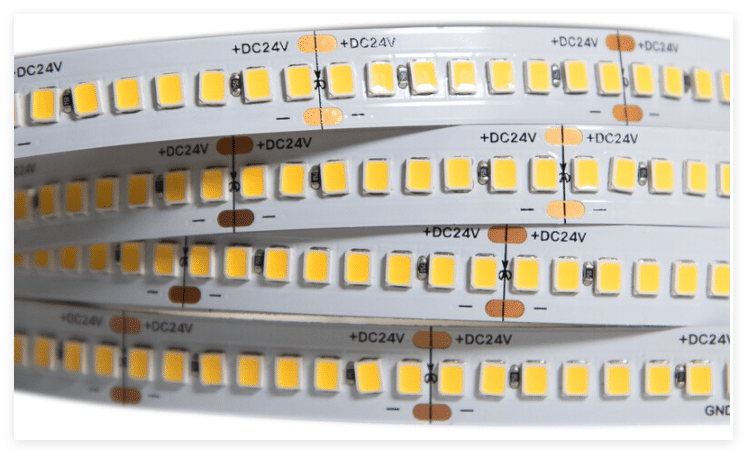
Getting Ready to Install
Prepare well to make your LED strip lights work properly. First, clean and dry the surface where you’ll stick the strips. Dirt or water can make the strips fall off or light unevenly. Next, measure and mark the spots where the strips will go. This helps the lighting look neat and smooth.
If you need to cut the strips, only cut at marked points. Cutting in the wrong place can break the circuit. After cutting, join the pieces with connectors or soldering. Test the strips before sticking them to check if they work.
Tip: Follow the maker’s instructions for cutting and joining strips to avoid damage.
Mounting the Strips Correctly
Mounting strips the right way keeps them strong and working well. Most strips have sticky backs, but you can use brackets for extra support. Brackets stop strips from peeling off, especially in hot or wet places.
Press the strip firmly onto the surface when mounting. Don’t bend it sharply, as this can harm the LEDs. For long strips, use a 24V power supply to keep the brightness even.
Note: Good mounting makes your LED strip lights last longer and look better.
Keeping Strips in Good Condition
Take care of your LED strips to make them last longer. Clean them often to remove dust and dirt. This stops overheating and keeps the light bright. Lowering the brightness to 70-80% can also help the strips last longer.
Make sure the strips stay cool by allowing airflow. High-density strips with heat sinks are better at handling heat. Proper mounting stops damage from shaking, especially in busy areas.
Tip: Cleaning and dimming save energy and keep your LED strip lights bright for years.
High-density LED strips give smooth light without visible dots. This makes them great for modern and practical designs. You can adjust their brightness and colours to suit your needs.
Research shows brightness, colour warmth, and IP rating are key for strong and useful lighting anywhere.
Special software like DIALux proves they work well indoors and outdoors.
Pick high-density LED strips to improve your lighting projects with top quality and adaptability.
FAQ
How do you recognise high-density LED strip lights?
Look at the number of LEDs per metre. High-density strips have 60 or more LEDs per metre. They give brighter and smoother light.
Can high-density LED strips be used outside?
Yes, they can. Make sure they have an IP65 rating or higher. This keeps them safe from water and dust, perfect for outdoor use.
Where can you learn about high-density LED strips?
Check websites like high density LED strip Reddit. People share reviews, tips, and ideas there. This helps you choose the right lights for your needs.
See Also
Selecting The Perfect LED Strip Lights For Linear Lighting
Comparative Analysis Of High-Brightness LED Strips For Use
Choosing The Ideal RGB LED Strip To Suit Your Requirements
